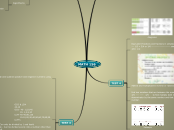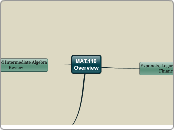Hyperbolic "Pythagorean" Identities
coth^2 (x) - 1 = csch^2 (x)
1 - tanh^2 (x) = sech^2 (x)
cosh(x) - sinh(x) = 1
VM266 0847
Curious aren't you?
Chapter 10: Improper Integrals
10.4 Integrals with discontinuity in between
10.3 Integrals with infinite limits
10.2 More indeterminate forms
10.1 0/0, inf/inf
L'hopital's Rule
Cauchy's Formula
Chapter 8: Hyperbolics, Inverse Trig
8.4: Inverse Hyperbolic Functions
arc csch x
(d/dx) arc csch x
arc sech x
(d/dx) arc sech x
arc coth x
(d/dx) arc coth x
arc tanh x
(d/dx) arc tanh x
arc cosh x
(d/dx) arc cosh x
arc sinh x
(d/dx) arc sinh x
8.3: Hyperbolic Functions
csch x
csch(x) = 1 / sinh(x) = 2 / (e^x - e^(-x))
Integral of csch u
Integral of csch(x)coth(x) = -csch x + C
(d/dx) csch u
sech x
sech(x) = 1 / cosh(x) = 2 / (e^x + e^(-x))
Integral of sech u
Integral of sech(x)tanh(x) = -sech x + C
(d/dx) sech u
coth x
coth (x) = cosh(x) / sinh (x) = (e^x + e^(-x)) / (e^x - e^(-x))
Integral of coth u
Integral of csch^2 x = -coth x + C
(d/dx) coth u
tanh x
tanh (x) = sinh(x) / cosh(x) = (e^x - e^(-x)) / (e^x + e^(-x))
Integral of tanh u
integral of sech^2 x = tanh x + C
(d/dx) tanh u
cosh x
cosh x = [(e^x) + (e^-x)] / 2
Integral of cosh u
Integral of sinh x = cosh x + C
(d/dx) cosh u
sinh x
sinh x = [(e^x) - (e^-x)] / 2
Integral of sinh u
integral of cosh x = sinh x + C
(d/dx) sinh u
8.1 + 8.2: Inverse Trigonometric Functions
arc csc
If arc csc(x) = y, then csc(y) = x
x must be defined on (-inf, -1] U [0, inf)
y must be defined on [-pi/2, pi/2], hole at 0
(d/dx) arc csc(x) = -1/x(rad(x^2 -1))
i) csc(arc csc(x)) = x; if x is defined on (-inf, -1] U [1, inf)
ii) arc csc(csc(x)) = x; if x is defined on [-pi/2, pi/2], hole at 0
arc sec
If arc sec(x) = y, then sec(y) = x.
x is defined on (-inf, -1] U [1, inf)
y is defined on [0, pi/2) U [pi, 3pi/2)
(1/a) arc sec(u/a) + C
(d/dx) arc sec(x) = 1/x(rad(x^2 -1))
i) sec(arc sec(x)) = x; if x is defined on (-inf, -1] U [1, inf)
ii) arc sec(sec(x)) = x; if x is defined on [0, pi/2} U [pi, 3pi/2)
arc cot
If arc cot(x) = y, then cot(y) = x.
x is defined on (-inf, inf)
y is defined on [0, pi]
(d/dx) arc cot(x) = -1/(1 + x^2)
i) cot(arc cot(x)) = x; if x is defined on (-inf, inf)
ii) arc cot(cot(x)) = x; if x is defined on (0, pi)
arc tan
If arc tan(x) = y, then tan(y) = x.
x is defined on (-inf, inf)
y is defined on (-pi/2, pi/2)
(1/a) arc tan(u/a) + C
(d/dx) arc tan(x) = 1/(1 + x^2)
i) tan(arc tan(x)) = x; if x is defined on (-inf, inf)
ii) arc tan(tan(x)) = x; if x is defined on (-pi/2, pi/2)
arc cos
if arc cos(x) = y, then cos(y) = x.
x is defined on [-1, 1]
y is defined on [0, pi]
(d/dx) arc cos(x) = -1/rad(1 - x^2)
i) cos(arc cos(x)) = x; if x is defined on [-1. 1]
ii) arc cos(cos(x)) = x; if x is defined on [0, pi]
arc sin
If y = arc sin(x), then sin(y) = x.
domain of arc sin [-1, 1]
range of arc sin [-pi/2, pi/2]
arc sin(u/a) + C
(d/dx) arc sin(x) = 1/rad(1 - x^2)
Properties
i) sin(arc sin(x)) = x; if x is defined on [-1,1]
ii) arc sin(sin(x)) = x; if x is defined on [-pi/2, pi/2]
Chapter 7: Inverses, Ln, e
7.5: Exponentials
(d/dx) log base a of x
e as a limit
a^x = e^(xln(a))
integrals of a^x and a^u
integral of a^x = (1/ln(a)) * a^x + C
integral of a^u = (1/ln(a)) * a^u + C
(d/dx)a^x = (a^x) ln(a)
7.4: Integration
Derivations of integral of trig functions
csc(u)
sec(u)
tan(u) and cot (u)
integral of e^x
integral of e^u
integral of 1/x
integral of 1/x = ln(x) + C
integral of 1/u
7.3: The letter e
Definition of e
e is a positive number where ln(e) = 1 <=> e is the base of ln(x)
e^x
(d/dx) e^x & (d/dx) e^u
Properties of Exponents
1. (e^p)(e^q) = e^(p+q)
2. (e^p)/(e^q) = e^(p-q)
3. (e^p)^q = e^pq
7.2: Logarithms
Logarithmic Differentiation Guildelines
Given a differentiable equation, do the following to differentiate logarithmically:
1. Take ln of both sides
2. Differentiate both sides...IMPLICIT DIFFERENTIATION MAY BE NEEDED ALONG THE WAY
3. Multily by the initial equation.
Ptoperties of logarithms
1. log base x of x => ln(e) = 1
2. log(a) + log(b) = log(ab)
3. log(a) - log(b) = log(a/b)
4. a log(b) = log(b^a)
----------------
More basic stuff: log base a of y = x, then y = a^x
Definition of natural log
The natural logarithmic function is a logarithm with base e.
In addition, it is also found that...
ln(x) = integral {(1/t) dt} from 1 -> x
----------------------
If x > 1, ln(x) = integral {(1/t) dt} from 1 -> x
If 0 < x < 1, -ln(x) = integral {(1/t) dt} from x -> 1
integral of ln(x)
Derived using integration by parts!!!
(d/dx) ln(x) = 1/x
Shortcut proof:
1. By defn of ln's, ln(x) = integral {(1/t) dt} from 1 -> x.
2. ln(x) must be differentiable because it is the antiderivative of something (1/t)
3. (d/dx) ln(x) = (d/dx) integral {(1/t) dt} from 1 -> x
4. (d/dx) ln(x) = 1/x, the derivative of an integral of a function is the function itself.
-----------------------------
(d/dx) ln(u) = (1/u)du
proof:
1. let y = f(x) = ln(u)
2. (dy/dx) = (dy/du)(du/dx)
3. f'(x) = (d/du) ln(u) * du
(d/dx) ln(u) = u'/u
integral of (1/u) du = u'/u; given that u is a function.
Proven from chain rule of (d/dx) ln(x)
(d/dx) ln(u) = (d/du) ln(u) * (du/dx) = (1/u)du
7.1: Inverses
Inverse Function
The inverse of a function that maps from D -> R is the function that maps from R -> D.
Let y = f(x) be a 1 - 1 function that maps from D - > R. A function g is the inverse of f where the R(f) = D(g) and D(f) = R(g).
Therefore, y = f(x) <=> x = g(y)
The inverse function g is denoted as f^-1
Derivative of an inverse fn.
g(f(x)) = x; f(g(x)) = y
If g is the inverse of f, then...
i) g(f(x)) = x for every x in D(f)
ii) f(g(x)) = x for every x in R(f)
-------------------
Ver1 proof is set as hyperlink
Ver2 proof URL: http://i1321.photobucket.com/albums/u556/radicaldreamer18/Calculus%202%20Chapter%207/IMAG0299_zps9a60cf31.jpg
1-1 Functions
1 - 1 functions are functions that never takes the same value twice.
More formally:
1. Let f be a function that maps from D -> R
2. For every x in D, there exist a unique R.
- Let x1, x2 be in D
- f(x1) is not = f(x2)
NOTE:
A) #2 implies the converse: for every y in R, there exist a unique x in D
B) Graphically, a function is 1 - 1 if a horizontal line never intersects the function's curve twice.
Every increasing/decreasing function is 1 - 1
Chapter 9: More integration
9.6 Other substitution tricks
9.5 Integrals with Quadratic Expressions
1. Look for a quadratic equation in the integrand.
2. Complete the square.
3. a. set u = the perfect square from the completed square
b. solve for x using u.
4. plug in u accordingly and and x as well
5. evaluate integral
9.4 Integrls of Rational Functions
Use partial fractions then evaluate integral
9.3 Trig. Substitions
x = a sinb if rad(a^2 - x^2) is in the integrand
x = a tanb if rad(a^2 + x^2) is in the integrand
x = a secb if rad(x^2 - a^2) is in the integrand
9.2 Trig. Integrals of different powers
Subtopic
9.1 Integration by Parts
integral of (u dv) = uv - integral of (v du)









